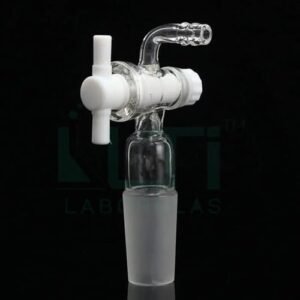- Made from ASTM E-438 Type 1, Boro 3.3 heat resistance glass
- Available Three Neck Parallel
- Complies with DIN 12392 & USP standard
| PART No. | Capacity (ml) | Centre Size | Side Socket | Overall Height | PACK Qty. |
| 5660-100 | 100 | 19/26 | 14/23 | 105 | 1 |
| 5660-100-A | 100 | 14/23 | 14/23 | 105 | 1 |
| 5660-100-B | 100 | 24/29 | 14/23 | 105 | 1 |
| 5660-100-C | 100 | 24/29 | 19/26 | 105 | 1 |
| 5660-250 | 250 | 24/29 | 19/26 | 140 | 1 |
| 5660-250-A | 250 | 19/26 | 19/26 | 140 | 1 |
| 5660-250-B | 250 | 29/32 | 14/23 | 140 | 1 |
| 5660-250-C | 250 | 29/32 | 29/32 | 140 | 1 |
| 5660-500 | 500 | 24/29 | 19/26 | 163 | 1 |
| 5660-500-A | 500 | 19/26 | 19/26 | 163 | 1 |
| 5660-500-B | 500 | 29/32 | 14/23 | 163 | 1 |
| 5660-500-C | 500 | 29/32 | 19/26 | 163 | 1 |
| 5660-500-D | 500 | 29/32 | 29/32 | 163 | 1 |
| 5660-1000 | 1000 | 24/29 | 19/26 | 200 | 1 |
| 5660-1000-A | 1000 | 29/32 | 14/23 | 200 | 1 |
| 5660-1000-B | 1000 | 29/32 | 19/26 | 200 | 1 |
| 5660-1000-C | 1000 | 29/32 | 24/29 | 200 | 1 |
| 5660-1000-D | 1000 | 29/32 | 29/32 | 200 | 1 |
| 5660-2000 | 2000 | 24/29 | 19/26 | 240 | 1 |
| 5660-2000-A | 2000 | 29/32 | 19/26 | 240 | 1 |
| 5660-2000-B | 2000 | 29/32 | 29/32 | 240 | 1 |
| 5660-2000-C | 2000 | 34/35 | 19/26 | 240 | 1 |
| 5660-2000-D | 2000 | 34/35 | 24/29 | 240 | 1 |
| 5660-3000 | 3000 | 34/35 | 24/29 | 260 | 1 |
| 5660-3000-A | 3000 | 34/35 | 19/26 | 260 | 1 |
| 5660-5000 | 5000 | 34/35 | 19/26 | 305 | 1 |
| 5660-5000-A | 5000 | 34/35 | 24/29 | 305 | 1 |
| 5660-10000 | 10000 | 34/35 | 24/29 | 380 | 1 |
| 5660-10000-A | 10000 | 45/40 | 24/29 | 380 | 1 |
| 5660-20000 | 20000 | 55/44 | 24/29 | 435 | 1 |
Here are some common uses for a 3-Neck Parallel Round Bottom Flask:
- Parallel Reactions: The primary use is for conducting multiple reactions simultaneously, with each neck facilitating a separate reaction vessel.
- Distillation and Fractionation: The flask can be used for distillation setups where different components of a mixture are collected through the three necks. Fractionation processes can be efficiently carried out using this flask.
- Refluxing: Each neck can be utilized for separate reflux setups, allowing researchers to perform multiple reflux reactions concurrently.
- Simultaneous Sampling: The three necks enable the simultaneous sampling of reaction mixtures or the introduction of different materials at various stages of the experiment.
- Temperature Control Experiments: One or more necks can be used for inserting thermometers or temperature probes, providing precise temperature control for each reaction.
- Gas Inlet/Outlet: One or more necks can be used for gas inlets or outlets, making the flask suitable for reactions involving gaseous reactants or by-products.
- Reaction Monitoring: The additional necks allow for the incorporation of monitoring devices, such as sensors or probes, to track reaction progress in multiple vessels.
- Parallel Distillation: Similar to parallel reactions, the flask can be used for parallel distillation, allowing researchers to simultaneously distill multiple samples.
- Complex Experimental Setups: The versatility of a 3-neck parallel flask facilitates the creation of complex experimental setups involving various reaction components, monitoring devices, or additional equipment.







